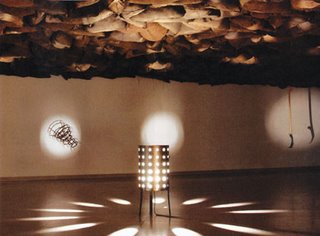I.
Little-known even among New York's cultural cognoscenti, The Hispanic Society of America, located on Broadway between 155 and 156 Streets in Manhattan's Morningside Heights neighborhood -- hence its lack of notoriety -- houses one of the city's finest collections of Golden Age and Impressionist-era Spanish art, which given in particular the breadth of the Metropolitan Museum's collection in the former area, is no small accomplishment. Chief among its treasures, and indeed among all the works that contribute to New York's glorious panoply of aesthetic riches, is Francisco José de Goya y Lucientes' Duchess of Alba (1797), a work that almost single-handedly (literally, as it happens) points the way to the modern period of which Goya is thought to be the ancestor. Specifically, Goya's Duchess points with her lowered arm to the painter's signature traced in the sand; that her toe is also pointing further directs our attention, while suggesting that she might be the author of this message. In this way, Goya prefigures a movement whose principle earmark is its positioning of the artist as the center of the work -- just as the Renaissance's distinction can be said to consist of, once again, making man the measure of all things. Not only does the artist paint his signature, but he makes it the focus of the viewer's attention. This definition of modernism, to be sure, includes romanticism, which again the "Duchess of Alba" signals in its move away from neoclassicism and toward a more modern conceptualization of artist as genius. Yet, this is not the definition of modernism that another of New York's epochal canvases signifies -- Pablo Picasso's Les Demoiselles d'Avignon (1907), which reinterprets space to dispose of Renaissance perspective in exchange for a multiplanar space-time that is closer to a set of syntagmas than it is to any traditional definition of the objective world -- though it does share its predilection for reflexivity, giving shape to what might be called art's mirror phase.
Beyond its abundant art historical significance, this portrait of the lady in traditional dress showcases Goya's debt to fellow Iberian master Diego Velázquez in its painterly treatment of the woman's garment -- that is, Goya's brushstrokes are often visible, especially in his representation of her gold-lattice sleeves; her lips are pulled tight into a pucker, commensurate with his simplification of means down to the level where his depiction of this feature and this feature alone succeeds in communicating personality; and indeed, in his facility with the color black itself: this final characteristic is determinate of his abstract "black paintings" phase, and is also something, parenthetically, that I noticed of the best Manet's (particularly his 1873 Masked Ball at the Opera) in my recent, first-ever visit to the National Gallery in Washington, DC. To the last of these, the point is that he produces a texture in his utilization of black that is noticeable for its near singularity in visual art. That a work of this stature should appear to be propped up on a table top, leaning against an abutting wall -- fear not it is tied up with thin wires -- perfectly condenses this work's (and the Hispanic Society in general)'s neglect.
What makes this all the more unfortunate is the alluded to largess of the museum's permanent collection. Aside from Goya -- there are other substantial works by the master including his "Brigadier General Alberto Foraster" (1804) with its Moorish-patterned metallurgy and its eyes worthy of Rembrandt -- the Hispanic Society has no shortage of Spain's consensus pre-modern masters, including the aforementioned Velázquez. In his case, the Society possesses (among other works) the beautiful small-canvas Portrait of a Young Girl (c.1642-43), which confirms Velázquez's complete mastery of texture in a very immediate and exacting fashion: the girl's soft brown hair, done up in something of a bob, precisely registers its weight and tactility, while its beautiful auburn color, along with the girl's like-colored eyes, smallish chin and soft, thin lips collectively encapsulate the girl's ideal, pre-pubescent beauty. It may be worth mentioning that the girl is thought to have been one of the painter's grandchildren.
Another familial connection featured at the museum links the slightly earlier, though no less well-renowned El Greco (Domenikos Theotokopoulos) and his son Jorge Manuel Theotosopuli, whose derivative (of his father that is) "Supper at the House of Simon" is displayed in the gallery space. The former, moreover, maintains one of the biggest presences at the Hispanic Society, with his striking middle-period The Holy Family (c. 1585) standing out among the lot. "The Holy Family" features an exceedingly beautiful and feminine Mary breast-feeding the Christ child, who tightly clasps two of his mother's fingers in his tiny little hand. Rarely has Christ's pre-Age of Consent humanity, Mary's graceful sensuality and their biological mother-son bond been show with this same level of exactitude. If this work, along with an earlier "Pieta" (c. 1570-75) show El Greco to be a son of the late Renaissance, his later, masterful "Penitent St. Jerome" (c. 1600) offers evidence of the maestro's late-period invention of a highly mannerist technique with his figure's very small head, elongated torso and gray beard, the ecstasy written across his face and picked up in the surrounding storm clouds, and the mauve form (a city perhaps) hovering in the upper left corner of the canvas. Given the evolution of his aesthetic on display at the Hispanic Society, it is difficult to support the sentiment (which I have heard voiced, and may have echoed myself) that El Greco is something akin to the last of the Medievals. Furthermore, an aesthetic such as his does provide art historians with a bridge from that earlier age to a modernity that owes much to Domenikos Theotokopoulos' internal way of seeing.
Beyond the big three of pre-Picasso Spanish painting, the artist to figure largest at the museum is Joaquin Sorolla y Bastida, who in fact preceded Pablo by a mere generation. The grandest of his featured pieces, and certainly the most monumental work at the museum, is his fourteen panel Visions of Spain (1913-19), which encircle a gallery space flanking the main exhibition hall, for which they were commissioned directly. Arranged in an order to reflect each region's location within the greater Iberian Peninsula, these large pastel panels impress more for their scope -- which to be sure is quite remarkable -- than for their level of craftsmanship, not that they are in any way lacking in this respect. At least they can be easily examined by the museum patron, unlike much of the work that adorns the narrow corridor walls of this turn-of-the-century palace.
Outside of the medium of painting, The Hispanic Society's decorative objects span the greater portion of the Peninsula's history, from Imperial Roman rule (a personal favorite of mine was the museum's collection of tweezers -- not typical art gallery stuff), Moorish control (a 10th century ivory box made by Halaf at Córdoba; a 15th century Mudejar door) and Catholic Spain (a Toledo baptismal font from 1400 and a pair of intact 16th century tombs, replete with larger-than-life marble effigies of the dead). Indeed, I might have even concluded that The Hispanic Society's greatest riches were to be found in these countless artifacts, had I not been greeted by one of New York's greatest art treasures (seemingly) balancing on a card table.
Not content with my brief visit to the museum, I supplemented my taste for all things Spanish later that same day with a very belated first viewing of Whit Stillman's Barcelona (1994). The funny thing about seeing it now is that it has become a very current film. Stillman's second feature is the story of an American salesman and his Navy officer cousin as they attempt to navigate Catalunya's very liberal and often openly anti-American society during the "last decade of the Cold War." The film opens with Fred's (Stillman axiom Chris Eigeman, who is exceptionally well-suited to this form of comedy) surprise arrival at Ted's (Taylor Nichols) apartment. Ostensibly there to prepare for a broader military visit, Fred doesn't hesitate to show his disdain when faced with hostility: as he points out, "it's well-known that anti-Americanism has its roots in sexual impotence. Then again, when one character does concede that Fred is intelligent for an American, he responds dryly, "no, I am not."
Like his marvelous debut Metropolitan (1990), Barcelona is a erudite, conversation-heavy comedy of manners -- a post-modern Eric Rohmer with an Upper Manhattan sensibility -- that, like his later The Last Days of Disco (1998), focuses upon a historical moment that has already passed (which could similarly said of Metropolitan and its description of New York's debutante scene). Here, in his treatment of European anti-American sentiment during the final years of the Cold War, Stillman surrenders nothing to his European betters, who continually speak of the AFL-CIA with knowing hauteur. His American characters, on the other hand, have problems of their own -- not the least of which is Ted's Bible-dancing -- but there is something to be said for a good hamburger, and we're not talking that crap that they have over there. Stillman is a very American director, but of a type that we have been led to believe doesn't exist (or at least not anymore): the refined, urban moralist -- dare we even say conservative, though not necessary right-wing -- for whom manners are everything. Barcelona is made current for its resistance to anti-Americanism, which in Stillman's version is largely supported by a mythic evil; if the recourse to inventing bogeymen bares any similarity to the anti-Americanism of today, it is, as they say, purely coincidental.









